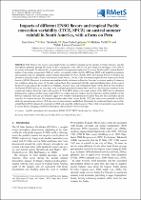Impacts of different ENSO flavors and tropical Pacific convection variability (ITCZ, SPCZ) on austral summer rainfall in South America, with a focus on Peru
Fecha
2018-01Colecciones
- Artículo científico [171]
Resumen
El Niño in the eastern and central Pacific has different impacts on the rainfall of South America, and the atmospheric pathways through the South Pacific Convergence Zone (SPCZ) and Inter-Tropical Convergence Zone (ITCZ) are poorly understood. To address this, we performed linear regression analysis of E (eastern Pacific) and C (central Pacific) indices of sea surface temperature (SST), as well as precipitation indices for the SPCZ and ITCZ, with gridded precipitation and reanalysis data sets during the austral summer (December–February) for the 1980–2016 period. Positive C induces dry anomalies along the tropical Andes and northern South America (NSA), while wet anomalies prevail over southeastern South America (SESA). Moreover, it produces wet conditions in the northwestern Peruvian Amazon. In contrast, positive E enhances wet conditions along the coasts of Ecuador and northern Peru associated with the southward displacement of the eastern Pacific ITCZ and induces dry conditions in Altiplano, Amazon basin, and northeastern Brazil (NEB). Both El Niño Southern Oscillation (ENSO) indices are associated with weakened upper-level easterly flow over Peru, but it is more restricted to the central and southern Peruvian Andes with positive E. Both SPCZ indices, the zonal position of the SPCZ and its latitudinal displacement, suppress rainfall along western Peruvian Andes when are positive, but the latter also inhibits rainfall over the Bolivian Altiplano. They are also linked to upper-level westerly wind anomalies overall of Peru, but these anomalies do not extend as far south in the first. The southward displacement of the eastern Pacific ITCZ also induces wet anomalies in SESA while dry anomalies prevail over NEB, the western Amazon basin, and Bolivia. Oppositely, the southward displacement of the central Pacific ITCZ induces dry anomalies in NEB and along the northern coast of Peru; while wet anomalies occur mainly in eastern Brazil, Paraguay, and Bolivia through an enhancement of the low level jet.








